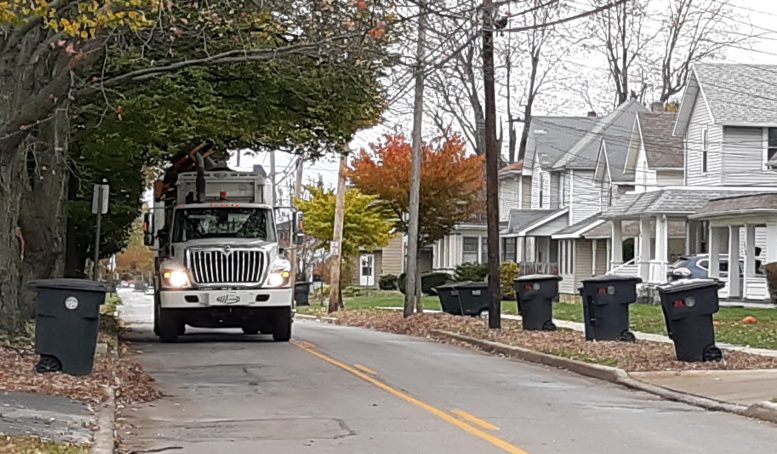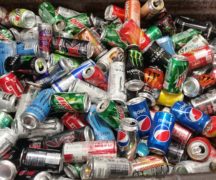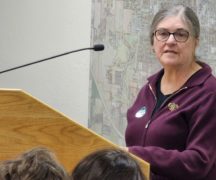By JAN LARSON McLAUGHLIN
BG Independent News
Bowling Green residents kept more than 38% of their household waste from being landfilled last year. That compares to the national diversion rate of 32%.
“We are pleased to report that number for Bowling Green,” Municipal Administrator Lori Tretter said to City Council on Tuesday evening.
The city’s refuse and recycling programs saw some upheaval last year due to COVID-19. The trash generated changed as people were ordered to stay home, as people quarantined, and as BGSU students learned remotely.
The city saw a 0.16% increase in municipal solid waste over 2019 – compared to a 30% increase seen in other Ohio cities.
“2020 was a unique year for many reasons,” Tretter said.
At the same time, the city’s recycling rate jumped by 23% – possibly due to the new recycling program that accepts glass and other items that weren’t accepted before.
This year, the city is trying another pilot project to divert waste from the landfill. In March, a food waste compost site will be opened near the yard waste drop-off site by the city’s public works garage.
The launch of this composting program will include the distribution of 5-gallon composting containers for the first 250 residents who request one.
“That’s terrific news about the compost program coming in March,” council member John Zanfardino said.
“Our community has so much to be proud of when it comes to waste diversion and sustainability generally,” council member Jeff Dennis said after the meeting. “While other Ohio cities have seen huge increases in the amount of waste they generated during last year’s stay-at-home order, Bowling Green saw an increase of less than one percent. This is just the most recent example of our community’s leadership on this important issue.”
Dennis said he is also pleased that the community continues to look for new ways to re-evaluate the waste stream and improve the services offered to residents.
“The new pilot composting program being implemented in March will allow Bowling Green to further reduce waste while creating valuable compost as a byproduct,” Dennis said. “With individuals and businesses increasingly prioritizing sustainability, this investment will not only benefit our existing residents but also help drive economic growth moving forward.”
Following are some details from the annual report on city refuse and recycling services, compiled by the city’s Sustainability Coordinator Amanda Gamby:
REFUSE
Trash is picked up once a week, plus residents may also schedule two free large item pickups throughout the year. The city also provides a special collection of mattresses for a fee.
- 2020 trash tonnage: 5086.78 tons (0.16% increase compared to 2019)
- Total large item pickups: 524
- Residents with one pickup: 472
- Residents with two pickups: 52
RECYCLING
Mixed recycling is collected curbside from once per week. Since Jan. 1, 2020, all mixed recycling is delivered to a transfer station in Toledo and then transported to a material recovery facility operated by Republic Services Inc. in Oberlin. Residents may now recycle an expanded list of materials.
Residents who do not receive curbside collection are directed to use the 24-hour drop off provided by the Bowling Green Recycling Center Inc.
It’s difficult to determine if the city’s 23% increase in collected recyclables is a result of the “stay at home” order or the result of the expanded list of accepted materials. The inclusion of glass adds significant weight to the tonnage of curbside recyclables being collected, so we suspect it is a combination of the two.
- 2020 mixed curbside recycling tonnage: 999.76 tons (23% increase compared to 2019)
- Bowling Green Recycling Center 24-hour drop off tonnage: 860 tons
CONTAMINATION
Republic only reports on recycling contamination if their audit control person reports an issue. The city has not received any complaints on delivered loads. All city curbside trucks are outfitted with cameras and the drivers report violations daily. These are tracked, and notices/educational materials are mailed. House visits/bin checks are performed for repeat offenders when necessary. When multiple education attempts fail, civil warnings/citations are issued.
Twelve percent of addresses receiving curbside service received direct feedback during 2020. The most frequently reported issue continues to be bagged recyclables:
- 588 “No Bags” warning postcards mailed
- 128 “No Bags” warning follow up letters and brochures for repeat bags mailed
- 72 “Garbage/Non‐recyclables” warning letters mailed
- 18 “Yard Waste” warning letters mailed
- 26 “Bin Placement” reminder letters mailed
- 52 House visits for repeat addresses
- 12 Civil warnings/citations issued
RECYCLE COACH
The City continues to provide Recycle Coach as a tool for residents to use. Recycle Coach is available on the City’s website and can also be downloaded as an app. The “What Goes Where?” Tool provides a searchable database directing residents to proper disposal/recycling locations for televisions, household hazardous wastes, paint, plastics, electronics, common recyclables, etc. Recycle Coach also provides a collection calendar and push notifications to remind residents of collection days, schedule changes, and special collections.
- 2020 Resident Interactions: 66,753
- 2020 App/Web App Users: 774
ORGANICS RECYCLING
BRUSH
Brush collections are offered in April, May, September, and October. Residents must call to be added to the collection route. Brush is delivered to Wood County’s Yard Waste Recycling Facility and is ground/screened into mulch in the spring. This mulch is available to residents for purchase.
Weather during 2020 did not warrant additional collections. This could be the reasoning behind the significant decrease in tonnage collected when compared to 2019.
- 2020 brush tonnage: 292.18 tons (24.12% decrease compared to 2019)
- Total 2020 brush pickups: 2,241
- Residents with 1 pickup: 833
- Residents with 2 pickups: 374
- Residents with 3 pickups: 144
- Residents with 4 pickups: 57
LEAVES & YARD WASTE
Leaves are collected curbside during a special collection in the fall/winter. The city added a map to the website this year allowing residents to follow along with progress and better prepare for crews to be in their neighborhood.
Overall the collection took five weeks and 323 trips to the Wood County Landfill’s Yard Waste Recycling facility where the leaves will be composted. The county is not permitted to sell the finished compost but uses it on site. Residents are also encouraged to mulch their leaves back onto their yards or utilize them in their flowerbeds, garden, compost, etc.
2020 resulted in a noticeable reduction in the tonnage of leaves collected curbside. This could be attributed to more residents mulching their leaves on their properties and/or composting. It could also be attributed to drier weather when the leaves were collected (wet leaves weigh more than dry leaves).
The city also operates a year‐round Yard Waste Drop Off Site behind the Public Works Garage, off Tarragon Drive. This site accepts leaves, grass, and other yard waste materials. Brush is not accepted at this site. All yard waste is delivered to the county’s yard waste recycling facility for composting.
- 2020 curbside leaves tonnage: 687.5 tons (11.63% decrease compared to 2019)
- 2020 yard waste drop off tonnage: 348.14 tons (0.57% increase compared to 2019)
CHRISTMAS TREE RECYCLING
Christmas trees are collected curbside during a one‐week collection in January. The trees are delivered to the county’s yard waste recycling facility and, like brush, are ground/screened into mulch in the spring.
- 2020 Collected Christmas Trees: 389
FOOD WASTE
The city is preparing for the launch of a pilot food waste compost drop off. The drop off will open to Bowling Green residents in March 2021. The city is working with GoZero to place six 96‐gallon containers at the public works garage, specifically near the public yard waste drop‐off near Tarragon Drive. Signage and educational materials will be placed at the site and a community education campaign will encourage usage and discourage contamination. Site usage, tonnage collected, contamination issues, and cost will be monitored for six months and a recommendation will be made in August for the future of this site.
This program is highly reliant on community outreach. The goal is to get the word out to residents about how to use the composting site.
Bagged material will not be permitted, so the city will be encouraging the use of lidded buckets to transport household food waste to the site. While residents may use any bucket/container they chose, 5‐gallon buckets with lids will be distributed to the first 250 residents to request one to help launch the program. The buckets will contain educational materials and a label displaying the list of acceptable materials.





